If you think Britain is rarely hit by earthquakes, think again.
Since 1970, the country has been struck by around 10,000 quakes.
Now, researchers have plotted each one of them on to an interactive map, in a bid to identify the UK’s earthquake hotspots.
“We wanted to examine where the UK’s earthquakes had occurred to see if any patterns emerged and uncover the myth that the country doesn’t get that many,” Ben Flanagan, a cartographer at Esri UK, told HuffPost UK.
Using British Geological Survey (BGS) data dating back to 1970, the team identified the following ten hotspots:
- Edinburgh (Scotland)
- Gweek, Cornwall (England)
- Clackmannan (Scotland)
- Llyn Peninsula (Wales)
- Stoke-on-Trent (England)
- Mansfield (England)
- Manchester (England)
- Knoydart Peninsula (Scotland)
- Dumfries (Scotland)
- Blackpool (England)

Each year, between 200 and 300 earthquakes are detected and located in the UK by BGS.
The research council explains why it’s important to keep a close eye on seismic developments:
“Although distant from the nearest plate boundary, the Mid-Atlantic Ridge, earthquakes occur as crustal stresses within the tectonic plates are relieved by movement occurring on pre-existing fault planes.
“The risk from these earthquakes is not insignificant and must be considered when engineering for sensitive installations.”
The most damaging British earthquake of the last few centuries hit Colchester in 1884. With a magnitude of 4.6 ML, the quake destroyed chimneys, roofs, walls and even church spires.
